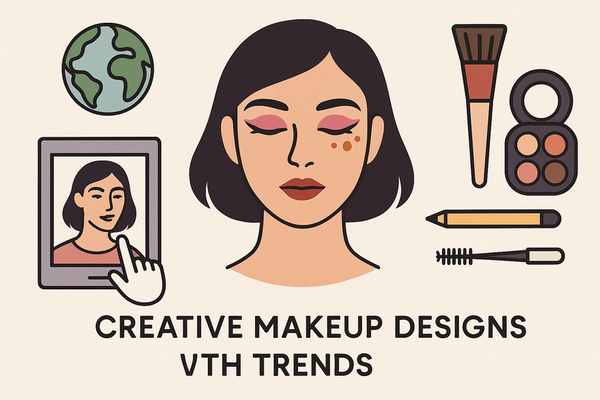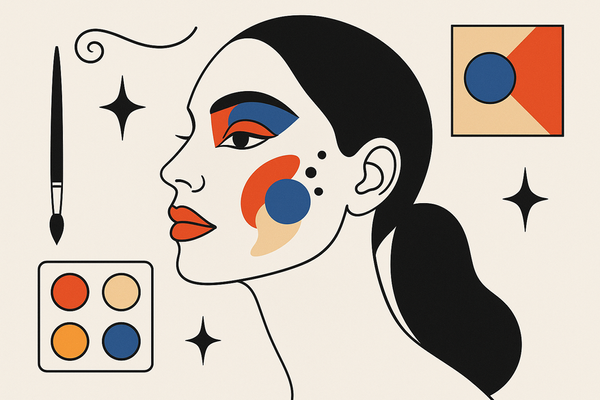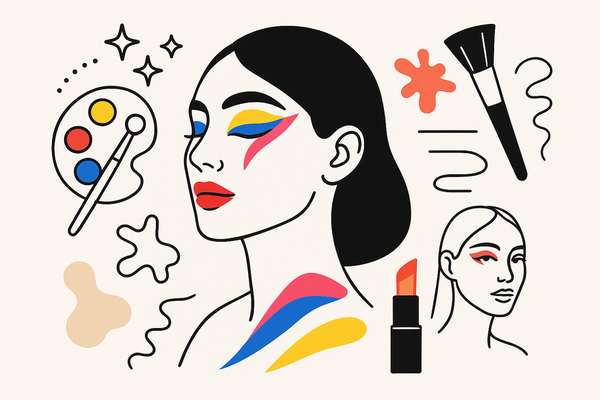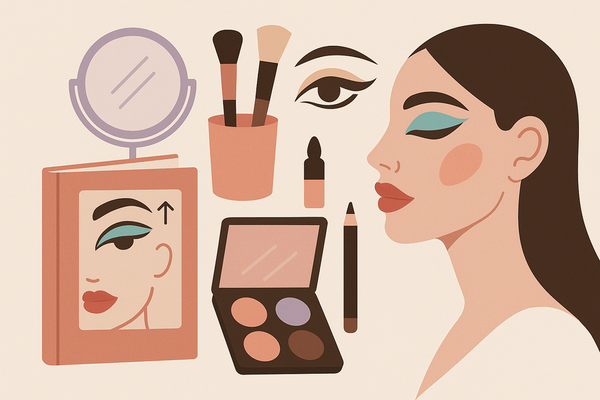Creative Makeup Designs: Your Guide to Artistic Cosmetic Applications
Explore creative makeup designs to transform faces into living canvases with artistic cosmetic applications. Learn techniques and get inspired to express your identity.
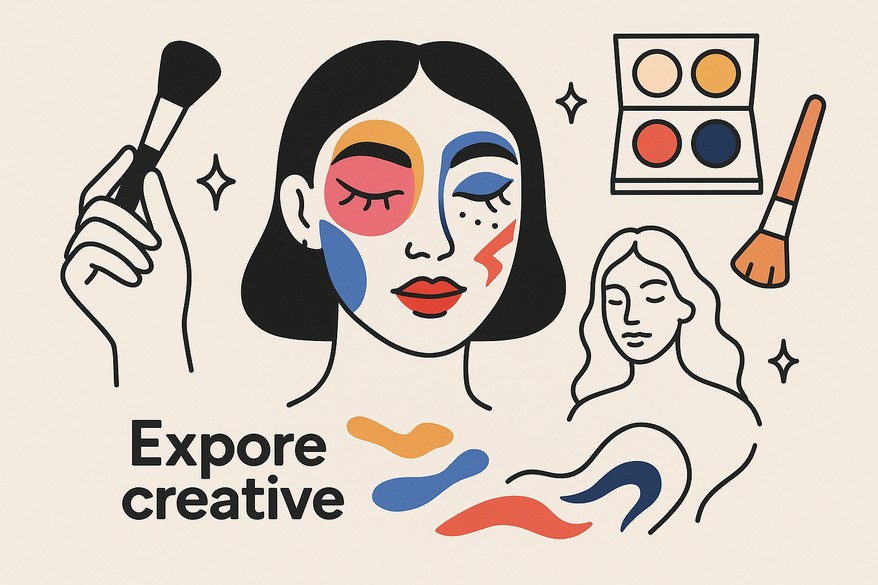
Estimated reading time: 8 minutes
Key Takeaways
- Makeup has evolved from tribal face painting to avant-garde art forms.
- Master fundamental techniques like color blending, contouring, and graphic lines.
- Use face charts to plan designs and avoid mistakes.
- Draw inspiration from social media trends and renowned artists.
- Experiment with DIY projects to build confidence and unleash creativity.
Table of Contents
- Historical Context and Evolution
- Key Elements of Creative Makeup Designs
- Step-by-Step Approaches and Tips
- Inspirations and Trends
- DIY and Experimentation
- Conclusion
- Additional Resources
Creative makeup designs blend art and cosmetics to go beyond simple beauty. These artistic cosmetic applications turn faces into living canvases and open up endless possibilities for self-expression and storytelling.
Why creative makeup designs are popular:
- They break traditional beauty norms and celebrate individuality.
- They enhance fashion shows, stage performances, and social media content.
- They provide a bold medium for expressing identity and mood.
Historical Context and Evolution
Creative makeup designs did not appear overnight. Early humans used body painting to mark rites of passage, with symbols denoting power, status, and clan identity. Over centuries, these symbolic adornments evolved into structured cosmetic rituals.
Cultural influences shaped modern stylized makeup:
- Japanese Kabuki theater: bold white base with red and black accents to define characters.
- Indigenous face-painting: natural pigments and geometric lines to tell stories.
- African tribal designs: dots and stripes used in ceremonies and for protection.
20th-century art and entertainment drove dramatic change:
- Silent films demanded high-contrast makeup for cameras and stage lights.
- Avant-gardist artists introduced abstract, sculptural face art.
- Runway shows embraced theatrical expression, pushing boundaries of beauty.
Key Elements of Creative Makeup Designs
At the heart of every standout look is precise color blending, which uses seamless pigment transitions to build depth and drama.
Core elements include:
- Color blending: mix complementary hues (blue and orange) for contrast, or analogous shades (pink, red, coral) for smooth gradients.
- Unique textures: layer creams, metallic foils, pearls, gems, or mini prosthetics for 3D body art.
- Graphic lines: use fine brushes or eyeliner to draw sharp geometric shapes or abstract patterns.
- Contouring & highlighting: sculpt cheeks, jaw, and nose with light and shadow for dramatic effect.
- Innovative tools & materials:
- Water-activated face paints for full-coverage color.
- Alcohol-based FX products for sweatproof finishes.
- Skin-safe adhesives for stick-on gems and prosthetics.
- High-pigment palettes and specially shaped brushes for precision.
Step-by-Step Approaches and Tips
Planning is crucial to avoid mistakes in creative makeup designs. Use face charts to map color zones, textures, and focal points before touching skin.
- Conceptualize the design: sketch on paper or a printable face chart, marking areas for highlights, shadows, and bold patterns.
- Master color theory: complementary colors bring energy (purple and yellow), while analogous hues (teal, blue, green) create harmony.
- Prepare the canvas: cleanse, moisturize, and prime for long-lasting wear.
- Layer techniques: start with foundation and contour/highlight, then build broad color areas, add texture, and finish with graphic lines.
- Apply embellishments: use cosmetic-grade adhesive to place gems or prosthetics individually.
- Set and seal: dust translucent powder and mist with setting spray.
- Troubleshooting: keep makeup remover handy, avoid over-blending, patch-test adhesives, and work in good light.
- Select colors & materials: match tones to skin undertones and choose products for the event and climate.
Inspirations and Trends
Social media platforms spark creativity and set new benchmarks in makeup artistry. Viral challenges push fans and artists to experiment with galaxy faces, mirrored looks, and bold color blocking.
Current trend examples:
- Zigzag and heart-shaped graphic liners on eyelids.
- Neon or pastel palettes across brows, cheeks, and lips.
- 3D stickers and face gems for festival-ready shimmer.
- Metallic highlights on temples, collarbones, and lips.
Role of TikTok & Instagram:
- Step-by-step reels teach painting techniques in seconds.
- Hashtags like #FantasyMakeup and #ArtisticFace guide beginners to pro demos.
- Collaborative challenges encourage remixing fellow artists’ ideas.
Influential avant-garde artists and runway icons:
- Pat McGrath experiments with jewel-encrusted makeup.
- Isamaya Ffrench fuses prosthetics with surreal shapes.
- Alexander McQueen shows inspire dark, gothic face art.
Seasonal & special-event themes include spring florals, Halloween skeleton contours, and holiday glitter motifs.
DIY and Experimentation
Creative makeup designs grow with trial and error. At-home labs let you test textures, pigments, and themes without professional pressure.
Getting started with simple projects:
- Graphic liner accents: draw a single neon line under your brow.
- Accent gems: stick two gemstones at the outer corner of each eye.
- Painted floral motifs: use a thin brush to dot small petals on cheeks.
For a seamless, AI-assisted approach to experimenting with color and effects, try Makeup Check AI, which offers instant creative looks and product matches in seconds.
Conclusion
Creative makeup designs unite technical skill and endless imagination. They challenge beauty norms and let anyone tell a visual story with pigments, textures, and shapes.
Key takeaways:
- History shows makeup as art, from tribal body painting to avant-garde runway.
- Master the basics: color blending, contouring, graphic lines, and skin prep.
- Plan with face charts, choose the right tools, and layer products in order.
- Stay inspired by social media trends and artist portfolios like Artistic Makeup Inspiration.
- Practice DIY projects to build confidence and style.
Each face you paint is a chance to express your unique vision. Embrace artistic freedom and continue exploring new tools, materials, and ideas.
Additional Resources
- Video tutorials: search “Pat McGrath eye art” and “Isamaya Ffrench FX makeup” on YouTube.
- Online galleries: browse avant-garde portfolios at Design Encyclopedia for fresh ideas.
- Expert reading: check Makeup Designory workshops and A’ Design Award makeup category.
- Competitions: enter industry contests to benchmark your designs and get professional feedback.
FAQ
- What is creative makeup design?
Creative makeup design is the use of cosmetics as an artistic medium, turning facial features into a canvas for color, texture, and patterns. - How do I plan a creative makeup look?
Use face charts to sketch ideas, select a cohesive color palette, and outline areas for texture, highlights, and graphic lines. - What essential tools do I need?
Invest in high-pigment palettes, fine brushes, diverse textures (foils, pigments), face charts, and skin-safe adhesives. - How can I practice at home?
Start with simple accents—neon liners, gems, or small floral motifs—then gradually combine techniques as you build confidence. - Where can I find inspiration?
Explore hashtags like #FantasyMakeup on TikTok and Instagram, watch pro reels, and review avant-garde artist portfolios.

